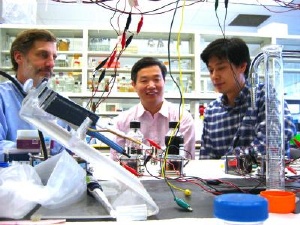Mar 30 2009
A tiny microbe can take electricity and directly convert carbon dioxide and water to methane, producing a portable energy source with a potentially neutral carbon footprint, according to a team of Penn State engineers.
 This photo shows Bruce E. Logan, Shaoan Cheng and Defeng Xing with a microbial cell that produces methane directly from electricity. Credit: Bruce Logan's Lab, Penn State
This photo shows Bruce E. Logan, Shaoan Cheng and Defeng Xing with a microbial cell that produces methane directly from electricity. Credit: Bruce Logan's Lab, Penn State
"We were studying making hydrogen in microbial electrolysis cells and we kept getting all this methane," said Bruce E. Logan, Kappe Professor of Environmental Engineering, Penn State. "We may now understand why."
Methanogenic microorganisms do produce methane in marshes and dumps, but scientists thought that the organisms turned hydrogen or organic materials, such as acetate, into methane. However, the researchers found, while trying to produce hydrogen in microbial electrolysis cells, that their cells produced much more methane than expected.
"All the methane generation going on in nature that we have assumed is going through hydrogen may not be," said Logan. "We actually find very little hydrogen in the gas phase in nature. Perhaps where we assumed hydrogen is being made, it is not."
Microbial electrolysis cells do require an electrical voltage to be added to the voltage that is produced by bacteria using organic materials to produce current that evolves into hydrogen. The researchers found that the Archaea, using about the same electrical input, could use the current to convert carbon dioxide and water to methane without any organic material, bacteria or hydrogen usually found in microbial electrolysis cells. They report their findings in this week's issue of Environmental Science and Technology.
"We have a microbe that is self perpetuating that can accept electrons directly, and use them to create methane," said Logan.
Logan, working with Shaoan Cheng, senior research associate; Defeng Xing, post doctoral researcher, and Douglas F. Call, graduate student, environmental engineering, confirmed that the microscopic organisms produced the methane. The researchers created a two-chambered cell with an anode immersed in water on one side of the chamber and a cathode in water, inorganic nutrients and carbon dioxide on the other side of the chamber. They applied a voltage, but recorded only a minute current. The researchers then coated the cathode with the biofilm of Archaea and not only did current flow in the circuit, but the cell produced methane.
"The only way to get current at the voltage we used was if the microbes were directly accepting electrons," said Logan. He notes that the electrochemical reaction takes place without any precious metal catalysts and at a lower energy level than converting carbon dioxide to methane using conventional, non-biological methods.
The cells are about 80 percent efficient in converting electricity to methane and because they use carbon dioxide as feed stock, would be carbon neutral if the electricity comes from a non-carbon source such as solar or wind power.
"The process does not sequester carbon, but it does turn carbon dioxide into fuel," said Logan. "If the methane is burned and carbon dioxide captured, then the process can be carbon neutral."
Logan suggests the method for off peak capture of renewable energy in a portable fuel. Methane is preferred over hydrogen because a large portion of the U.S. infrastructure is already set up to easily transport and deliver methane.